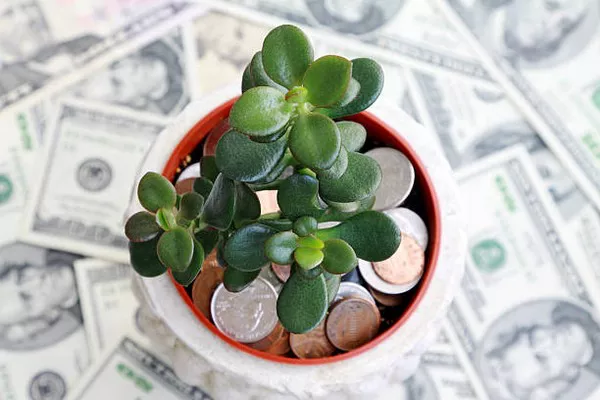Jade plants (Crassula ovata), often referred to as the “money plant” or “lucky plant,” are renowned for their resilience and elegant appearance. These charming succulents have graced homes and offices for generations, but their appeal goes beyond their ornamental beauty. Understanding how jade plants grow and how to care for them is essential to keep these delightful succulents flourishing in your space. In this comprehensive guide, we will explore the life cycle, environmental requirements, propagation techniques, and maintenance tips for jade plants, ensuring that you can enjoy their prosperity for years to come.
Understanding the Jade Plant
Native to South Africa, jade plants are part of the Crassulaceae family. Their characteristic round, fleshy leaves and woody stems have led to their association with coins, making them popular choices for houseplants. These succulents are known for their striking appearance, but their growth habits are equally fascinating.
Life Cycle of Jade Plants
To understand how jade plants grow, it’s crucial to consider their life cycle. Jade plants exhibit a combination of drought tolerance and succulent traits that enable them to thrive in arid conditions. They are perennial, meaning they can live for several years, and with proper care, they can grow into impressive specimens.
Here’s a basic overview of the jade plant’s life cycle:
a. Germination: Jade plant seeds are small and relatively easy to grow, but they require a well-draining potting mix and consistent moisture to germinate successfully.
b. Seedlings: Young jade plants start with small, green leaves. They require more moisture in their early stages of life, but this should be reduced as they grow to encourage their drought resistance.
c. Mature Plants: As jade plants mature, they develop thick, woody stems and the characteristic fleshy, oval leaves that we recognize. They can grow up to 3 feet in height.
d. Flowering: When conditions are ideal, mature jade plants can produce star-shaped, white or pink flowers. While not always guaranteed, this flowering adds another layer of beauty to the plant.
Environmental Requirements
Jade plants are relatively low-maintenance, but they do have specific environmental requirements that must be met for optimal growth. Here are the key factors to consider:
a. Light: Adequate sunlight is crucial for jade plant growth. These succulents thrive in bright, indirect light. Place them near a south- or west-facing window to ensure they receive sufficient illumination. However, avoid direct, intense sunlight, as it can scorch their leaves.
b. Temperature: Jade plants prefer mild to warm temperatures. They thrive in the 65-75°F (18-24°C) range during the day and can tolerate slightly cooler temperatures at night. Protect them from drafts and extreme cold.
c. Soil: Well-draining soil is a must for jade plants. A cactus or succulent potting mix works well. You can also add some perlite or sand to improve drainage.
d. Watering: One of the most common mistakes in jade plant care is overwatering. These succulents store water in their leaves, so they prefer to dry out between waterings. Allow the soil to become mostly dry, and then water thoroughly. In general, water every 2-3 weeks, but adjust based on the specific environmental conditions and container size.
e. Potting: Use a well-draining pot with drainage holes to prevent waterlogged roots. Jade plants don’t mind being slightly root-bound, so repotting every 2-3 years is usually sufficient.
Propagation
If you want to share the beauty of your jade plant or expand your collection, propagation is a valuable skill to master. There are several methods to propagate jade plants:
a. Leaf Cuttings: This is the most common method. Simply take a healthy leaf from the plant, let it callus over for a day or two, and then plant it in a well-draining potting mix. Keep the soil lightly moist until the cutting roots and grows.
b. Stem Cuttings: You can also take stem cuttings from a healthy part of your jade plant. Allow the cut end to dry and callus over before planting in soil. Water sparingly until the cutting establishes roots.
c. Offsets: Jade plants sometimes produce offsets or “pups” at the base of the parent plant. These can be carefully removed and replanted.
d. Seeds: Growing jade plants from seeds is another option, although it can be more time-consuming and less predictable.
Maintenance and Care Tips
Maintaining a thriving jade plant requires a few essential practices:
Pruning: Regularly remove any dead or damaged leaves to encourage healthy growth. You can also prune for shape or size control if needed.
Fertilization: Jade plants don’t require much fertilization. During the growing season (spring and summer), apply a balanced, water-soluble fertilizer at half-strength every 2-3 months.
Pest Control: Jade plants are generally hardy, but they can be susceptible to common houseplant pests like mealybugs and spider mites. Regularly inspect your plant and treat any infestations promptly.
Watering: Overwatering is the most common mistake when caring for jade plants. Err on the side of underwatering, as they can tolerate drought much better than sitting in soggy soil.
Repotting: As mentioned earlier, jade plants prefer slightly crowded conditions, but they may need repotting every few years if they become severely root-bound or outgrow their containers.
Conclusion
Jade plants, with their unique appearance and remarkable resilience, are a delightful addition to any home or office. Understanding how these succulents grow and thrive is key to ensuring their long-lasting beauty. Remember the crucial factors of light, temperature, well-draining soil, and appropriate watering, and you’ll be well on your way to becoming a successful jade plant enthusiast. With proper care and maintenance, you can enjoy the prosperity and elegance of jade plants for many years, bringing good fortune and natural beauty into your living space.


